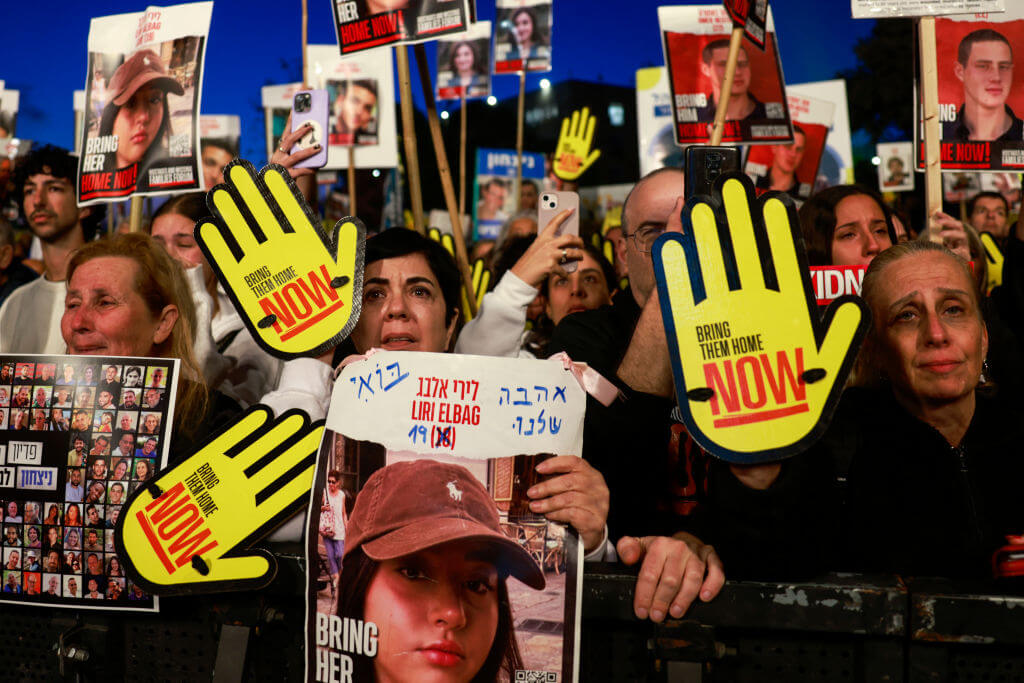Analysis: Are we on the cusp of a ceasefire and hostage deal?
Signs point to a deal within the coming days that would release less than half of the hostages still believed to be alive

Relatives and supporters of Israeli hostages April 7. Photo by Menahem Kahana/AFP via Getty Images
Israel appears to be nearing an agreement with Hamas which would temporarily end the fighting in the Gaza Strip and arrange for the release of some Israeli hostages. Such a deal has been elusive since the first ceasefire deal, which paused fighting for a week and allowed for the release of 112 hostages in November.
But indications that a new deal, involving 40 hostages, could be brokered soon are supported by comments from leading mediators, and the Israel Defense Forces’ movement in the enclave.
Majed Mohammed al-Ansari, spokesperson for Qatar’s foreign ministry, told the BBC Monday morning that, after a number of rounds of indirect negotiations between the two sides, he’s feeling “more optimistic” that a new deal could be achieved in the coming days.
This followed statements from Egyptian security sources, who said some progress had been made in weekend talks between Israeli, U.S., Qatar and Hamas representatives in Cairo.
As for the warring parties themselves, Hamas has expressed skepticism about a forthcoming deal, citing a deadlock over key demands. But Israel’s security cabinet is scheduled to meet Tuesday and Israeli Prime Minister Benjamin Netanyahu is engaging in one-on-one meetings with right-wing members of his cabinet to keep a deal on track.
Several factors favor a deal in the coming days.
Mounting American pressure
The U.S. recently went public over its frustration with Israel in hopes of pushing Netanyahu closer to an agreement. President Joe Biden in a phone call to Netanyahu on Thursday called for “an immediate ceasefire” and warned that the U.S. would adjust its support for Israel if it failed to address the dire humanitarian situation in Gaza.
On the heels of Biden’s phone call and a deadly strike on humanitarian aid workers from the World Central Kitchen, a group of 40 House members — including former House Speaker Nancy Pelosi, a longtime ally of Israel — and a number of Democratic senators signed a letter Friday urging Biden to halt a transfer of new arms to Israel and limit military aid to defensive weapons only.
American public opinion about Israel’s war against Hamas, following the Oct. 7 attack on Southern Israel, has shifted dramatically in recent weeks. A Gallup poll showed approval of Israel’s military action in Gaza dropped from 50% in November to 36% in March.
And in recent weeks, Biden has changed his tone toward Israel following a series of successful campaigns among Democratic primary voters frustrated with his failure to pressure Israel for a ceasefire.
Israel’s leaders, despite statements that it will prosecute the war against Hamas on its own terms, seem to be at least somewhat sensitive to the Biden administration’s insistence that it not invade Rafah, where more than a million Palestinians are sheltering. That invasion appears to have been delayed.
Israelis want the hostages home
Four months after watching the gradual return of 112 of the 240 hostages that were kidnapped by Hamas on Oct. 7, the families of the hostages are growing increasingly impatient with the deadlock. Ninety-eight hostages are still believed to be alive.
Widespread demonstrations across Israel have intensified in recent weeks. Freed hostages and relatives of the remaining hostages have joined increasingly large protests, with some echoing calls for new elections and a change of leadership.
A deal would alleviate at least some of the pressure on Netanyahu — 71% of Israelis say he should resign now or as soon as the war is over — and show that he had made progress on at least one of the main objectives the military campaign.
A strategic withdrawal from Gaza
Most Israeli troops have left Gaza in recent weeks, indicating a stage of the war where it may be easier for Israel to compromise.
The IDF said Sunday that most soldiers who operated in the southern city of Khan Younis have left Gaza. Just one brigade has remained to protect the security corridor that divides the northern from southern portions of the 9-mile-long strip.
Some Israeli experts described the withdrawal as part of a broader strategy to reduce tensions and pave the way for negotiations to come to fruition. And Defense Minister Yoav Gallant said the partial pullout has enabled Israel “to be flexible, to act freely and to make difficult decisions in order to bring back the abductees.” He called it an “opportune moment” in the war.
Will Hamas seize the opportunity?
Hamas during negotiations has insisted on a permanent ceasefire and the return of Palestinian civilians to northern Gaza without any Israeli checkpoints.
It’s not likely to negotiate that. Netanyahu has vowed to destroy Hamas and enter Rafah to eliminate the five Hamas brigades still intact.
But a new hostage deal could help Hamas achieve at least some of its goals. It wants an end to the fighting and the protection of its leaders, in hopes of leaving the group in control of Gaza. A ceasefire could hold, Hamas may hope, if overwhelming international pressure dissuades Israel from resuming large-scale military operations.
Publicly, Hamas is not echoing others’ optimism.
“There is no change in the position of the occupation (Israel) and therefore, there is nothing new in the Cairo talks,” the Hamas official, who asked not to be identified, told Reuters. “There is no progress yet.”
In a video statement Monday afternoon, Netanyahu signaled that he wants a hostage deal, but also that Israel won’t agree to a permanent ceasefire while Hamas still rules Gaza.
“We are constantly working to achieve our goals,” he said, “first and foremost the release of all our hostages and achieving a complete victory over Hamas.” He also said he had set a date for an Israeli invasion of Rafah — a date he did not disclose.






















